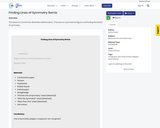
Videos that help students study elapsed time
- Subject:
- Mathematics
- Material Type:
- Visual Media
- Author:
- Krista Dascano
- Date Added:
- 08/02/2020

Videos that help students study elapsed time

This lesson is a remix from Illustrative Mathematics. It focuses on symmetrical figures and finding the line(s) of symmetry. Original lesson: https://goopenva.org/courses/4-g-finding-lines-of-symmetry

This video is part of the Continue to Know with WHRO TV series. Watch Claire Verdillo teach about how to determine the main idea and supporting details of nonfiction text.

If you wish to find only resources that have been loaded into #GoOpenVA using the Open Author software, this screencast shows you how.

A guide to locating public domain and creative commons resources, mostly focusing on images

A guide to locating public domain and creative commons resources, mostly focusing on images

In this professional development presentation, educators learn about Finding Patterns (1 of the 7 components of Computational Thinking, according the Ignite My Future platform). This presentation can be used by individuals to learn about them, or used to present to others. The video is a recording of one of the sessions provided to teachers through a 7 week series of "CT Parties".Within this resource, you will find the presentation slides, a recording, a K-2 and 3-5 lesson to build abstraction skills, and activities to support parents understanding and home use of the strategy. This lesson is part of the Virginia K-12 Computer Science Pipeline which is partly funded through a GO Virginia grant in partnership with Chesapeake Public Schools, Loudoun County Public Schools, and the Loudoun Education Foundation.

In this professional development presentation, educators learn about how to look at patterns (1 of the 7 components of Computational Thinking, according the Ignite My Future platform) in the world around you to make choices. This presentation can be used by individuals to learn about them, or used to present to others. The video is a recording of one of the sessions provided to teachers through a 7 week series of "CT Parties".Within this resource, you will find the presentation slides, a recording, a K-2 and 3-5 lesson to discover patterns, and activities to support parents understanding and home use of the strategy. This lesson is part of the Virginia K-12 Computer Science Pipeline which is partly funded through a GO Virginia grant in partnership with Chesapeake Public Schools, Loudoun County Public Schools, and the Loudoun Education Foundation.

In this activity, students must find solutions to quadratic equations in order to create a monster with specific characteristics.

This video is part of the Learn and Grow with WHRO TV series. Watch Alystra Barefoot teach about setting up a learning journal.

Students participate in a "thirty-second look," followed by a class discussion about Jan Brueghel's painting "The Entry of the Animals into Noah's Ark". Students then use description words and complete sentences to write about their favorite animal in the painting; draw the animal using line, color, and shape; and present their work to the class.

Students hang an object of known mass from a spring scale and submerge it to different depths in a liquid. By analyzing the change in the upward force of the spring scale, students are able to determine the density of the liquid.

This is a google slides mini lesson on finding the mean of a set of data. The first slide consists of the definition of mean. Students will solve what a mean is and will make a text box and type the answer in it, then complete the slides.

This is a google slides mini lesson on finding the mean of a set of data. The first slide consists of a definition of mean. Students will solve what the mean is and make a text box and type the answer init, then complete the slides.

This is a google slides mini lesson on finding the median of a set of data. The first slide consists of a definition of median. Students will solve what the median is and make a text box and type the answer. Then, they will complete all slides.

This is a google slides mini lesson on finding the mode of a set of data. The first slide consists of a definition of mode. Students will solve what the mode of the data is and make a text box for the answer. They will type the answer in the text box, then complete the slides.

This is a google slides mini lesson on finding the outlier of a set of data. The first slide consists of a definition of outlier. Students will solve what the outlier of the data is and make a text box for the answer. They will type the answer in the text box, then complete the slides.

This is a google slides mini lesson on finding the range of a set of data. The first slide consists of the definition of range. Students will solve what a range is and will make a text box and type the answer in it, then complete the slides.

This activity from Illustrative Mathematics has students determine the slope between ordered pairs. The last set of ordered pairs are variables instead of numbers.

This document contains a sample list of fine arts careers by discipline, links and resources for exploring fine arts careers, and resources for workbased learning in fine arts courses.